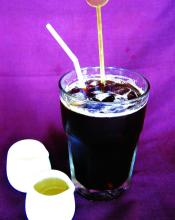Bright taste of Panamanian Pocket Flower Butterfly Coffee Bean Flavor Manor introduction to Ace
The distinction between Panamanian growing areas mainly depends on the sales situation of coffee, but mostly on geographical distribution. In the past, coffee was widely spread, and the following areas are actually one area, but these areas are closely linked.
Boquete
This is the Panamanian region that we are most familiar with. The special mountainous terrain of this area forms a microclimate which is very suitable for growing coffee. Cool weather and frequent fog slow down the ripening process of coffee cherries, and some even say that the climate can already simulate high-altitude planting.
Altitude: 400-1900m
Harvest period: December to March
Planting varieties: Tibica, Kaddura, Kaduai, bourbon, Rosa, San Ramon
Candela volcano
The area produces a lot of food for Panama, as well as excellent coffee. This area borders on Costa Rica.
Altitude: 1200-1600m
Harvest period: December to March
Planting varieties: Tibica, Kaddura, Kaduai, bourbon, Rosa, San Ramon
Renacimiento
Another producing area of Chirqui province, bordering Costa Rica. This producing area is relatively small, so it is not the main producing area of Panamanian boutique coffee.
Altitude: 1100-1500 m
Harvest period: December to March
Planting varieties: Tibica, Kaddura, Kaduai, bourbon, Rosa, San Ramon
This estate has led to the cultivation of "Geisha" in many coffee plantations not only in Panama but also throughout Central America. For many coffee farmers, this variety means a high price, and to a large extent, this perception is correct. Because as a manor that grows "Geisha", the price of its coffee is always higher than that of other estates.
Traceability of origin
Panamanian coffee has high traceability of origin. Generally speaking, the origin of coffee in Panama can be traced to a single manor or even to a field on the manor.
Flavor characteristics
The better coffee in Panama has citrus and floral aromas, bright taste, elegant and complex flavor.

Important Notice :
前街咖啡 FrontStreet Coffee has moved to new addredd:
FrontStreet Coffee Address: 315,Donghua East Road,GuangZhou
Tel:020 38364473
- Prev

Introduction to Hassanda Coffee Garden in Ecuador Coffee Manor
When Thomas and the crew landed on the island, they were frantically looking for water and were so thirsty that they squeezed juice from the fat leaves of the cactus to drink. At last a source of water was found in a rocky gully. Thomas attributed it to the gift of God, because it was good Friday, and they had piously celebrated mass before they set out in search of water. But Thomas will never
- Next

Colombia Coffee Flavor Taste Estate Introduction Lazmus Estate
The pure flavor of Colombia coffee comes from the natural environment of Colombia, which has the most favorable conditions for coffee growth. But beyond that, it is inseparable from the hard work of local growers. In Colombia, coffee is cultivated on 1.07 million hectares, there are about 302,000 coffee plantations in the country, and 30 to 40 per cent of the rural population depends directly on coffee production. Colombia
Related
- Does Rose Summer choose Blue, Green or Red? Detailed explanation of Rose Summer Coffee plots and Classification in Panamanian Jade Manor
- What is the difference between the origin, producing area, processing plant, cooperative and manor of coffee beans?
- How fine does the espresso powder fit? how to grind the espresso?
- Sca coffee roasting degree color card coffee roasting degree 8 roasting color values what do you mean?
- The practice of lattes: how to make lattes at home
- Introduction to Indonesian Fine Coffee beans-- Java Coffee producing area of Indonesian Arabica Coffee
- How much will the flavor of light and medium roasted rose summer be expressed? What baking level is rose summer suitable for?
- Introduction to the characteristics of washing, sun-drying or wet-planing coffee commonly used in Mantenin, Indonesia
- Price characteristics of Arabica Coffee Bean Starbucks introduction to Manning Coffee Bean Taste producing area Variety Manor
- What is the authentic Yega flavor? What are the flavor characteristics of the really excellent Yejasuffi coffee beans?

